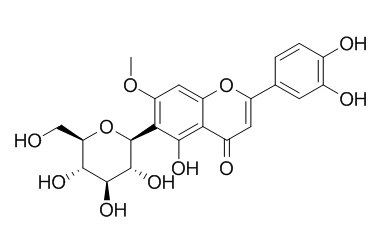Swertiajaponin
Swertiajaponin possesses antimicrobial activity.
Inquire / Order:
manager@chemfaces.com
Technical Inquiries:
service@chemfaces.com
Tel:
+86-27-84237783
Fax:
+86-27-84254680
Address:
1 Building, No. 83, CheCheng Rd., Wuhan Economic and Technological Development Zone, Wuhan, Hubei 430056, PRC
Providing storage is as stated on the product vial and the vial is kept tightly sealed, the product can be stored for up to
24 months(2-8C).
Wherever possible, you should prepare and use solutions on the same day. However, if you need to make up stock solutions in advance, we recommend that you store the solution as aliquots in tightly sealed vials at -20C. Generally, these will be useable for up to two weeks. Before use, and prior to opening the vial we recommend that you allow your product to equilibrate to room temperature for at least 1 hour.
Need more advice on solubility, usage and handling? Please email to: service@chemfaces.com
The packaging of the product may have turned upside down during transportation, resulting in the natural compounds adhering to the neck or cap of the vial. take the vial out of its packaging and gently shake to let the compounds fall to the bottom of the vial. for liquid products, centrifuge at 200-500 RPM to gather the liquid at the bottom of the vial. try to avoid loss or contamination during handling.
J Ethnopharmacol.2022, 282:114574.
Plant Science2024, 338:111914
Journal of Apicultural Research2021, 60(1)
Universite de Bordeaux2017, 2017BORD0867
J.Pharm. & Biome. Anal.2023, 2: 100018.
Molecules.2019, 24(16):E3003
Int J Mol Sci.2022, 23(1):538.
J Korean Soc Food Sci Nutr2020, doi: 10.3746.
LWT2021, 150:112021.
Pathol Res Pract.2024, :260:155445.
Related and Featured Products
Molecules. 2009 Sep 30;14(10):3906-13.
Inhibitory effect of three C-glycosylflavonoids from Cymbopogon citratus (Lemongrass) on human low density lipoprotein oxidation.[Pubmed:
19924037]
This study assessed the inhibitory effect of three C-glycosylflavonoids from Cymbopogon citratus leaves--isoorientin (1), Swertiajaponin (2) and isoorientin 2"-Orhamnoside (3)--on human LDL oxidation.
METHODS AND RESULTS:
Isolated LDL was incubated with compounds 1-3 and the kinetics of lipid peroxidation were assessed by conjugated diene and malondialdehyde-thiobarbituric acid reactive substances (MDA-TBARS) formation after addition of copper ions. Significant differences (p < 0.05) between the lag time phase of the control and the lag time phase in the presence of the compounds 1 (0.25 microM) and 2 (0.50 microM) were observed. After five hours of incubation all three compounds showed a significant inhibitory effect on MDA-TBARS formation with respect to the control. After six hours of incubation only compound 1 kept a remarkable antioxidant effect.
CONCLUSIONS:
This study demonstrates that isoorientin (1) is an effective inhibitor of in vitro LDL oxidation. As oxidative damage to LDL is a key event in the formation of atherosclerotic lesions, the use of this natural antioxidant may be beneficial to prevent or attenuate atherosclerosis.
J Agric Food Chem. 2005 Apr 6;53(7):2511-7.
Free radical scavengers and antioxidants from Lemongrass (Cymbopogon citratus (DC.) Stapf.).[Pubmed:
15796587]
METHODS AND RESULTS:
Methanol, MeOH/water extracts, infusion, and decoction of Cymbopogon citratus were assessed for free radical scavenging effects measured by the bleaching of the 1,1-diphenyl-2-picryl-hydrazyl (DPPH) radical, scavenging of the superoxide anion, and inhibition of the enzyme xanthine oxidase (XO) and lipid peroxidation in human erythrocytes. The extracts presented effect in the DPPH and superoxide anion assay, with values ranging between 40 and 68% and 15-32% at 33 and 50 microg/mL, respectively, inhibited lipid peroxidation in erythrocytes by 19-71% at 500 microg/mL and were inactive toward the XO at 50 microg/mL. Isoorientin, isoscoparin, Swertiajaponin, isoorientin 2' '-O-rhamnoside, orientin, chlorogenic acid, and caffeic acid were isolated and identified by spectroscopic methods. Isoorientin and orientin presented similar activities toward the DPPH (IC(50): 9-10 microM) and inhibited lipid peroxidation by 70% at 100 microg/mL.
CONCLUSIONS:
Caffeic and chlorogenic acid were active superoxide anion scavengers with IC(50) values of 68.8 and 54.2 microM, respectively, and a strong effect toward DPPH. Caffeic acid inhibited lipid peroxidation by 85% at 100 microg/mL.
Oncotarget . 2017 Sep 15;8(56):95530-95541.
Swertiajaponin inhibits skin pigmentation by dual mechanisms to suppress tyrosinase[Pubmed:
29221146]
Abstract
Many skin-whitening compounds target tyrosinase because it catalyzes two rate-limiting steps in melanin synthesis. Although many tyrosinase inhibitors are currently available for a skin-whitening purpose, undesirable adverse effects are also reported. Thus, numerous efforts have been made to develop safer tyrosinase inhibitors from natural products. In line with this, we tested fifty flavonoids, a group of naturally occurring antioxidants and metal chelators, and screened Swertiajaponin as the strongest tyrosinase inhibitor in cell-free experiments. Swertiajaponin did not show cytotoxicity in B16F10, HaCat, and Hs27 cells and exhibited strong anti oxidative activity in experiments using the cell-free system and B16F10 cells. It markedly inhibited αMSH- or UVB-induced melanin accumulation in B16F10 cells and suppressed skin pigmentation in a human skin model. As underlying mechanisms, in silico and Lineweaver-Burk plot analyses exhibited that Swertiajaponin may directly bind to and inhibit tyrosinase activity by forming multiple hydrogen bonds and hydrophobic interactions with the binding pocket of tyrosinase. In addition, western blotting results indicated that Swertiajaponin inhibited oxidative stress-mediated MAPK/MITF signaling, leading to decrease in tyrosinase protein level. Together, Swertiajaponin suppresses melanin accumulation by inhibiting both activity and protein expression levels of tyrosinase. Thus, it would be a novel additive for whitening cosmetics.
Keywords: human skin; melanogenesis; pigmentation; Swertiajaponin; tyrosinase.



